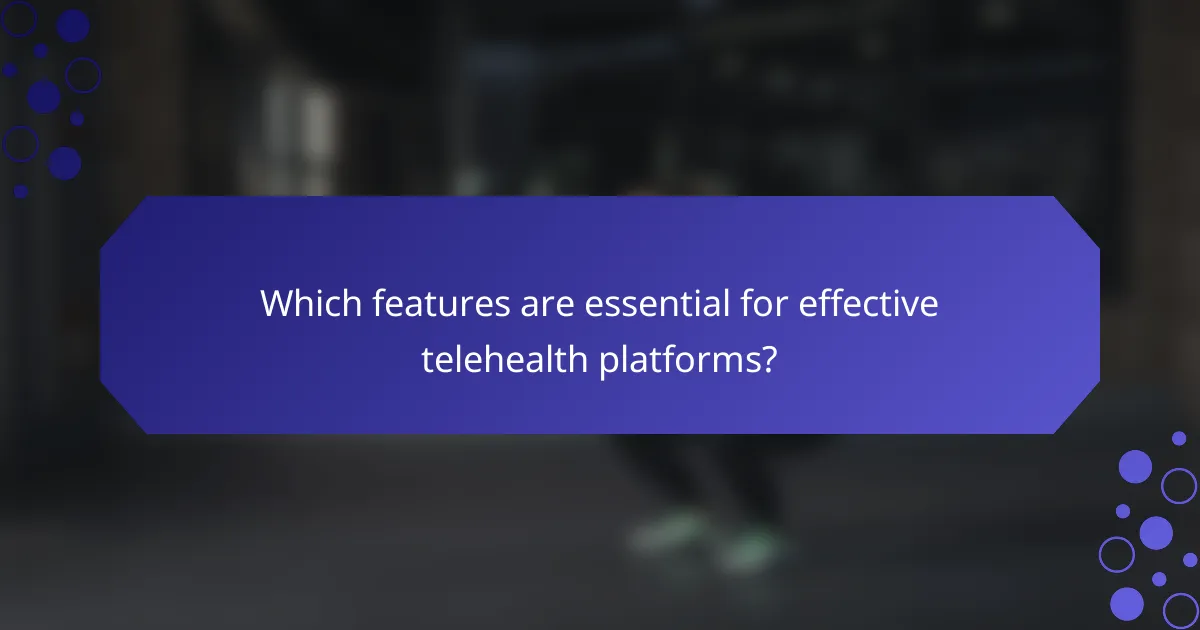Telehealth platforms enhance healthcare access and convenience while reducing costs. This article explores the essential features that improve user engagement, effective strategies for fostering interaction, and the challenges these platforms face in user adoption. Additionally, we will examine unique attributes that differentiate specific platforms and the impact of current trends on telehealth services.

What are the key benefits of telehealth platforms?
Telehealth platforms offer improved access to healthcare, convenience, and cost savings. They enable patients to consult with healthcare providers remotely, reducing travel time and associated expenses. Enhanced patient engagement through user-friendly interfaces and real-time communication fosters better health outcomes. Additionally, telehealth platforms often provide continuous monitoring and support, addressing both chronic and acute health issues effectively.
How do telehealth platforms improve patient access to care?
Telehealth platforms significantly enhance patient access to care by providing remote consultations and reducing geographical barriers. They enable patients to connect with healthcare providers via video calls, phone calls, or messaging. This flexibility allows for timely medical advice, especially for those in rural areas or with mobility issues. Moreover, telehealth platforms often offer extended hours, accommodating patients’ schedules and increasing engagement. Statistics show that telehealth usage surged by over 150% during the pandemic, highlighting its critical role in maintaining access to healthcare.
What cost savings can be achieved through telehealth?
Telehealth can achieve significant cost savings through reduced overhead, lower travel expenses, and improved efficiency. For instance, healthcare providers can save on facility costs and staff time. Patients benefit from decreased transportation costs and time off work. A study found that telehealth can reduce overall healthcare costs by up to 30%. These savings can enhance access to care while maintaining quality.
How do telehealth platforms enhance patient engagement and satisfaction?
Telehealth platforms significantly enhance patient engagement and satisfaction through convenience, accessibility, and personalized care. These platforms allow patients to access healthcare services remotely, reducing the barriers of travel and wait times. Features like secure messaging, video consultations, and appointment reminders foster continuous communication, increasing patient involvement in their health management.
Moreover, telehealth solutions often incorporate user-friendly interfaces and mobile applications, making it easier for patients to schedule appointments and access their health information. As a result, patients feel more empowered and satisfied with their healthcare experience. The integration of analytics tools further enables providers to tailor services based on individual patient needs, enhancing overall engagement.

Which features are essential for effective telehealth platforms?
Essential features for effective telehealth platforms include user-friendly interfaces, secure communication, appointment scheduling, electronic health record integration, and payment processing capabilities. These attributes enhance user engagement and ensure a seamless experience for patients and providers. Security measures, such as encryption and compliance with regulations, are also critical for protecting sensitive health information.
What role does user interface design play in telehealth usability?
User interface design significantly enhances telehealth usability by improving user experience and accessibility. A well-designed interface streamlines navigation, making it easier for patients to access services. Intuitive layouts and clear visual cues reduce frustration, leading to higher engagement rates. Furthermore, effective design can accommodate diverse user needs, such as varying levels of tech-savviness and accessibility requirements. This adaptability ensures that telehealth platforms remain inclusive and user-friendly, ultimately fostering better health outcomes.
How do integrated communication tools improve telehealth experiences?
Integrated communication tools enhance telehealth experiences by streamlining interactions and improving patient engagement. These tools facilitate real-time communication, ensuring patients receive timely support. Enhanced video conferencing features allow for clearer consultations, while integrated messaging systems keep patients informed. Additionally, data-sharing capabilities enable seamless access to medical records, fostering better decision-making. Overall, these tools contribute to a more efficient and user-friendly telehealth environment.
What security measures are critical for protecting patient data in telehealth?
Critical security measures for protecting patient data in telehealth include encryption, secure access controls, and regular security audits. Encryption safeguards data during transmission and storage, ensuring unauthorized access is prevented. Secure access controls, like multi-factor authentication, limit data access to authorized personnel only. Regular security audits identify vulnerabilities, allowing for timely updates and compliance with regulations.

How do user engagement strategies vary among telehealth platforms?
User engagement strategies among telehealth platforms vary significantly. They often include personalized communication, user-friendly interfaces, and integration with wearable devices to enhance patient interaction.
Platforms may utilize gamification techniques to motivate users, while others focus on educational content to improve health literacy. Telehealth services often implement feedback systems to refine user experience and increase satisfaction.
Additionally, some platforms leverage data analytics to tailor services based on user behavior and preferences, optimizing engagement. These diverse strategies reflect the unique attributes of each telehealth platform, addressing specific user needs effectively.
What are effective onboarding practices for new telehealth users?
Effective onboarding practices for new telehealth users include clear guidance, user-friendly interfaces, and personalized support. These strategies enhance user engagement and satisfaction.
1. Provide step-by-step tutorials to familiarize users with platform features.
2. Implement a user-friendly interface that simplifies navigation.
3. Offer personalized support through chatbots or live assistance.
4. Use feedback mechanisms to continually improve the onboarding experience.
5. Ensure data security and privacy are clearly communicated to build trust.
6. Foster community engagement through forums or support groups.
How can telehealth platforms utilize patient feedback for continuous improvement?
Telehealth platforms can enhance their services by actively integrating patient feedback into their development processes. This allows for the identification of areas needing improvement and fosters user engagement.
Collecting feedback through surveys, ratings, and direct communication helps platforms understand patient experiences. Analyzing this data reveals trends and specific issues, enabling targeted enhancements. For example, if patients report difficulties in navigation, platforms can simplify their user interface.
Implementing changes based on feedback demonstrates responsiveness, increasing patient trust and satisfaction. Regularly updating patients on improvements made from their suggestions maintains engagement and encourages future feedback.
Incorporating patient feedback is a continuous loop of improvement that not only enhances the platform’s usability but also strengthens the patient-provider relationship.
What gamification techniques can enhance user retention in telehealth?
Gamification techniques can significantly enhance user retention in telehealth by promoting engagement and motivation. Strategies include incorporating reward systems, progress tracking, and interactive challenges.
Reward systems, such as points or badges for completing health tasks, encourage users to stay active. Progress tracking features allow users to visualize their health journey, fostering a sense of accomplishment. Interactive challenges, like health quizzes or competitions, keep users engaged and invested in their telehealth experience.
By integrating these techniques, telehealth platforms can create a more compelling user experience, ultimately leading to higher retention rates.

What challenges do telehealth platforms face in user adoption?
Telehealth platforms face challenges in user adoption primarily due to technological barriers, privacy concerns, and lack of awareness. Many users struggle with unfamiliar technology, leading to frustration. Privacy issues create distrust, as users worry about data security. Additionally, insufficient marketing efforts result in low awareness of available telehealth services. Addressing these challenges is crucial for enhancing user engagement.
How do technological barriers impact telehealth usage?
Technological barriers significantly hinder telehealth usage by limiting access and functionality. Issues such as poor internet connectivity, outdated devices, and lack of digital literacy create obstacles for both patients and providers. For example, a study found that 25% of rural patients face connectivity issues, impacting their ability to engage with telehealth services. Additionally, some platforms require specific software or hardware, which can exclude users without the necessary resources. Addressing these barriers is crucial for enhancing user engagement and expanding telehealth’s reach.
What regulatory issues must telehealth platforms navigate?
Telehealth platforms must navigate a complex landscape of regulatory issues including licensing, reimbursement, privacy, and security. Compliance with state and federal laws is essential for operational legitimacy. For instance, platforms must ensure adherence to HIPAA regulations to protect patient data. Additionally, varying state laws regarding telemedicine practice can complicate service delivery across state lines. These regulatory challenges can impact the accessibility and affordability of telehealth services for users.
How can telehealth platforms address concerns about quality of care?
Telehealth platforms can enhance quality of care by ensuring consistent access to healthcare professionals. They utilize advanced technologies to facilitate real-time consultations, which improves patient engagement and satisfaction. Comprehensive data security measures protect patient information, fostering trust. Additionally, platforms often integrate monitoring tools that enable continuous patient assessment, leading to timely interventions.

Which unique attributes set specific telehealth platforms apart?
Unique attributes that set specific telehealth platforms apart include specialized services, user interface design, integration capabilities, and compliance features. For example, some platforms offer mental health services exclusively, while others excel in chronic disease management. User-friendly interfaces enhance engagement, making navigation intuitive. Integration with electronic health records improves data accessibility. Compliance features ensure adherence to regulations, which is essential for user trust.
What innovative features are offered by leading telehealth providers?
Leading telehealth providers offer innovative features such as real-time video consultations, AI-driven symptom checkers, and integrated patient management systems. These advancements enhance user engagement and streamline healthcare delivery.
Telehealth platforms utilize secure messaging to facilitate communication between patients and providers. They also provide remote monitoring tools, allowing continuous health tracking. Many platforms include personalized health plans, improving patient adherence and outcomes.
Additionally, some telehealth services offer multilingual support, catering to diverse populations. Enhanced data analytics capabilities allow providers to gain insights into patient trends, optimizing care delivery.
These features collectively represent the evolution of telehealth, making healthcare more accessible and efficient for users.
How do regional healthcare regulations influence telehealth platform capabilities?
Regional healthcare regulations significantly shape telehealth platform capabilities by dictating compliance requirements and operational standards. These regulations influence features such as data security protocols, patient privacy measures, and service accessibility. For instance, some regions mandate specific encryption standards, impacting how platforms manage user data. Additionally, regulations can limit the types of services offered, affecting user engagement strategies. Compliance with varying state laws requires platforms to adapt their functionalities, which can lead to unique offerings tailored to specific markets. As a result, telehealth platforms must navigate a complex landscape to effectively serve users while adhering to legal frameworks.
What partnerships enhance the functionality of certain telehealth platforms?
Partnerships with healthcare providers, technology companies, and data analytics firms enhance telehealth platforms’ functionality. These collaborations improve service delivery, patient engagement, and data security. For example, partnerships with electronic health record systems streamline access to patient information, while collaborations with AI companies enhance diagnostic capabilities. Integrating these technologies leads to improved patient outcomes and operational efficiency.

How do telehealth platforms adapt to different user demographics?
Telehealth platforms adapt to different user demographics through tailored features and user engagement strategies. They incorporate language options, accessibility features, and age-specific content to enhance user experience. For example, platforms may offer video consultations for older adults while providing chat options for younger users. Additionally, data analytics help identify trends and preferences within specific demographic groups, allowing for continuous improvement. As a result, telehealth services can effectively meet diverse healthcare needs across various populations.
What strategies work best for engaging elderly patients in telehealth?
Engaging elderly patients in telehealth requires tailored strategies that enhance usability and trust. Clear communication, user-friendly interfaces, and personalized follow-ups significantly improve their experience.
Utilize the following strategies to enhance engagement:
1. Simplify technology: Ensure the platform is easy to navigate with large buttons and clear instructions.
2. Provide training: Offer personalized tutorials to familiarize elderly patients with telehealth tools.
3. Foster relationships: Encourage regular check-ins to build rapport and trust with healthcare providers.
4. Involve caregivers: Include family members in consultations to provide additional support and understanding.
5. Ensure accessibility: Offer multiple communication options, including phone calls, for those uncomfortable with video.
These strategies can increase participation and satisfaction in telehealth services among elderly patients.
How do telehealth platforms cater to mental health services?
Telehealth platforms effectively cater to mental health services by providing accessible, flexible, and personalized care. They offer features such as video consultations, secure messaging, and appointment scheduling. These platforms enhance user engagement through tools like reminders, progress tracking, and educational resources. Additionally, they ensure privacy and confidentiality, which are crucial for users seeking mental health support.
Which approaches are effective for reaching rural populations through telehealth?
Telehealth platforms can effectively reach rural populations by utilizing mobile-friendly interfaces, offering asynchronous communication, and providing local partnerships for outreach. Tailoring services to fit the unique needs of rural users enhances engagement and accessibility.
Key strategies include:
1. Mobile optimization for easy access.
2. Asynchronous communication options for flexibility.
3. Collaborations with local healthcare providers.
4. Community education initiatives to raise awareness.
5. User-friendly interfaces to reduce technological barriers.
6. Continuous feedback mechanisms to improve services.

What future trends are shaping telehealth platforms?
Telehealth platforms are increasingly shaped by trends such as enhanced user experience, AI integration, and regulatory changes. These factors drive accessibility, personalization, and security in healthcare delivery.
User engagement strategies focus on real-time communication, remote monitoring, and gamification to improve adherence and satisfaction. As a result, platforms are evolving to meet diverse patient needs and preferences.
AI technologies, like chatbots and predictive analytics, optimize patient interactions and streamline administrative tasks. This leads to improved efficiency and better health outcomes.
Regulatory changes are promoting telehealth adoption, ensuring that services comply with privacy standards while expanding coverage. These trends collectively enhance the telehealth landscape, making it more responsive and user-friendly.
How will advancements in AI impact telehealth services?
Advancements in AI will significantly enhance telehealth services by improving patient engagement, diagnosis accuracy, and operational efficiency. AI algorithms can analyze patient data to provide personalized treatment plans and predictive analytics for better health outcomes.
AI-driven chatbots offer 24/7 support, answering patient queries and scheduling appointments, which increases user engagement. Additionally, machine learning can streamline administrative tasks, reducing wait times and improving overall service delivery.
These innovations lead to a more efficient telehealth experience, fostering better patient-provider relationships and enhancing healthcare accessibility.
What role does telehealth play in global health initiatives?
Telehealth significantly enhances global health initiatives by improving access to care. It allows remote consultations, reducing barriers such as distance and healthcare shortages. Telehealth platforms offer benefits like convenience, cost-effectiveness, and the ability to reach underserved populations. These platforms often feature user-friendly interfaces, secure communication, and integration with health records, boosting user engagement. As a result, telehealth plays a crucial role in promoting health equity and improving health outcomes worldwide.
How can telehealth platforms prepare for potential technological disruptions?
Telehealth platforms can prepare for technological disruptions by adopting flexible infrastructure and robust security measures. Investing in scalable cloud solutions ensures adaptability during high demand. Regular software updates and staff training enhance system resilience. Collaborating with tech partners fosters innovation and rapid response to challenges.
What best practices should telehealth platforms adopt for optimization?
Telehealth platforms should adopt best practices that enhance user experience, ensure data security, and optimize service delivery. Key strategies include implementing user-friendly interfaces, ensuring compliance with healthcare regulations, and utilizing robust cybersecurity measures. Regularly gathering user feedback can also improve engagement and satisfaction.
